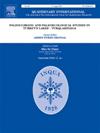Tracing natural and anthropic dynamics in alluvial and coastal plain through multidisciplinary sources: A new protocol for the study of historical landscapes in Val di Cornia (southern Tuscany, Italy)
IF 1.8
3区 地球科学
Q3 GEOGRAPHY, PHYSICAL
引用次数: 0
Abstract
The reconstruction of historical landscapes in alluvial and coastal plains is challenging due to the intense transformations of the territory caused by fluvial and coastal dynamics, as well as anthropogenic influences such as modern agricultural practices and land reclamation activities. Therefore, multidisciplinary studies and the use of a wide range of environmental proxies have become fundamental to evaluating the entangled interconnections between human activities and natural environmental processes within the context of landscape evolution.
This study explores the long-term interplay between humans and the environment in the lower Val di Cornia, an alluvial and coastal plain in central Italy (southern Tuscany) along the Tyrrhenian coast. Drawing on recent geomorphological analysis, the archaeological record has been reinterpreted within an updated environmental framework, further enriched by newly conducted geochemical and cartographic analysis. Spanning from the 7th century BC to the 11th century AD, this research aims to reconstruct both natural characteristics and the transformative role of human agency.
New data revealed that specific locations corresponding to elevated depositional fluvial features were particularly attractive for settlement due to their reduced hydraulic hazards and the coarse-grained soils resistant to water stagnation. However, settlement patterns were shaped not only by geomorphology but also by cultural and economic factors, including proximity to resources, access to road networks, and evolving land-use strategies. While this is particularly evident for the period between the 4th century BC to the 2nd century AD, when the archaeological record is more solid, a combination of variables has also been identified for describing Late Antiquity and the Early Middle Ages. Through the integration of diverse data sources, this study overcomes the chronological limitations inherent in individual records—archaeological, historical, or cartographic—enabling a broader understanding of landscape transformations.
通过多学科资源追踪冲积和海岸平原的自然和人为动力学:科尔尼亚山谷(意大利托斯卡纳南部)历史景观研究的新方案
冲积平原和沿海平原的历史地貌重建工作极具挑战性,因为河流和海岸动力学以及人 为活动(如现代农业实践和土地开垦活动)对这些地区造成了巨大的变化。因此,多学科研究和使用各种环境代用指标已成为评估地貌演化过程中人类活动与自然环境过程之间纠缠不清的相互关系的基础。本研究探讨了意大利中部(托斯卡纳南部)第勒尼安海沿岸的冲积和沿海平原 Val di Cornia 下部人类与环境之间的长期相互作用。利用最新的地貌分析,考古记录在最新的环境框架内得到了重新诠释,新进行的地球化学和制图分析进一步丰富了考古记录。新数据显示,与高地沉积河道地貌相对应的特定地点,由于其水力危害较小,且土壤颗粒较粗,不易积水,因此对定居具有特别的吸引力。然而,定居模式不仅受地貌学的影响,还受文化和经济因素的影响,包括靠近资源、通往公路网以及不断演变的土地使用策略。公元前 4 世纪到公元 2 世纪这一时期的考古记录更为详实,这一点在这一时期尤为明显。通过整合不同的数据来源,本研究克服了考古、历史或制图等单个记录在年代上的固有局限性,从而能够更广泛地了解景观的变化。
本文章由计算机程序翻译,如有差异,请以英文原文为准。
求助全文
约1分钟内获得全文
求助全文
来源期刊

Quaternary International
地学-地球科学综合
CiteScore
5.60
自引率
4.50%
发文量
336
审稿时长
3 months
期刊介绍:
Quaternary International is the official journal of the International Union for Quaternary Research. The objectives are to publish a high quality scientific journal under the auspices of the premier Quaternary association that reflects the interdisciplinary nature of INQUA and records recent advances in Quaternary science that appeal to a wide audience.
This series will encompass all the full spectrum of the physical and natural sciences that are commonly employed in solving Quaternary problems. The policy is to publish peer refereed collected research papers from symposia, workshops and meetings sponsored by INQUA. In addition, other organizations may request publication of their collected works pertaining to the Quaternary.
 求助内容:
求助内容: 应助结果提醒方式:
应助结果提醒方式:


